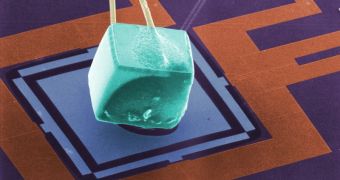Many people have heard about the phrase "absolute zero," not many know what it really implies, and fewer have asked themselves the question "what happens below absolute zero?" Are there upper and lower limits to temperature?
Absolute zero is known to be 0 K (-273.15 ?C, -459.67 ?F) and it's used to describe a theoretical system that neither emits nor absorbs energy. It's like a state where no atom and no subatomic particle moves. In fact, it's the point at which particles have a minimum energy, determined by quantum mechanical effects, which is called the zero-point energy.
But what does that mean and is it really the coldest cold, or just the lowest temperature that we can measure? So far, this temperature has never been achieved, and in theory it could never be achieved. In 1994, the NIST achieved a record cold temperature of 700 nK (billionths of a kelvin). In 2003, researchers at MIT eclipsed this with a new record of 450 pK (0.45 nK).
Physics professors Moses Chan and Evan Pugh, at Penn State say that near absolute zero, the matter stops acting the way it should and starts exhibiting some strange properties, dictated by the quantum states. "Temperature is a measure of the degree of 'disorder' or 'messiness' of a system," said Chan. "When a system is cooled down to absolute zero, then that system is perfectly ordered and all its constituents -- molecules and atoms -- are in their proper place. That is the lowest possible temperature."
Zero-point energy is, for example, the energy in the vacuum of empty space, and it's actually the lowest possible energy a system can have, so it's the only energy retained by atoms and molecules. "At low temperatures," Chan continued, "quantum mechanical effects dominate the properties of all matter."
For instance, at near absolute zero, some types of matter become superconducting, carrying electric current with absolutely no resistance, and some of them, like helium, become superfluid at this temperature, exhibiting absolutely no friction, becoming a Bose-Einstein Condensate (BEC). This means that a droplet of superfluid helium can rotate inside a container forever, as if it were in a vacuum.
Practical applications of this phenomena include high magnetic field MRI machines and very efficient electric motors and transformers.
The conclusion is that there is nothing below absolute zero, and this temperature can ever be achieved. "No, we can get very close, but never to absolute zero," Chan said. "Some labs, including David Weiss's here at Penn State, can cool vapor samples to within a few nanokelvins, or billionths of a degree. But to bring something to perfect order, you have to get rid of the disorder or messiness. As the system gets closer to absolute zero, it becomes progressively harder and harder to remove that disorder."

 14 DAY TRIAL //
14 DAY TRIAL //